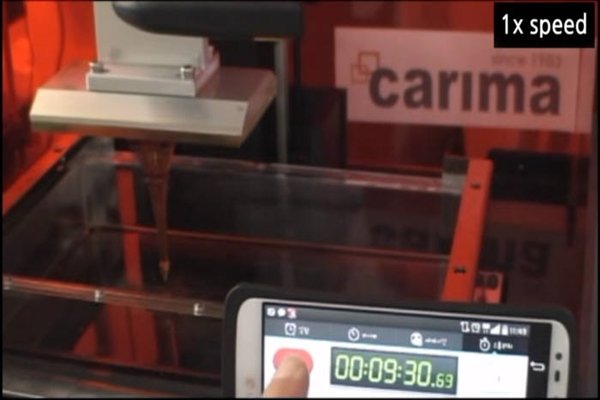It is now possible to mass-produce variety of different items through 3D printers.
Carima (CEO Lee Byung-geuk) announced on the 10th that it has developed fast printing technology called ‘C-CAT’, which is based on ‘mask projection image hardening method’ called DLP (Digital Light Processing). DLP is a method that projects beam projector onto photo-curable resin which is in a liquid form and it projects shape of an item onto a projector and stacks it while hardening it. Its characteristic is that items are printed out hanging upside down since beam projector is located on the bottom.
C-CAT is an ultra-fast 3D printing technology that can print items at 60cm/h. While it maintains quality of 3D artwork, it has rapidly increased printing speed. In just one hour, it can print out a 3D artwork with 60cm in size. Carima is explains that its technology is about 30% faster than technology of Carbon 3D, which is an American company that excels in this field.
Carima received an official approval from Korea Testing Certification regarding measurement of printing speed. Korea Testing Certification confirmed quality and time it takes to print out an Eiffel Tower (93.97mm x 51.60mm x 120.39mm). Carima also obtained NET (New Excellent Technology) certification from South Korean Government recently and was verified of its technology.
Corresponding technology was also registered as patents under the names of ‘serial stacking 3D forming method and device’ and ‘photo-curing 3D forming method and photo-curing 3D forming device’.

This technology has maintained strengths of DLP while its speed has increased as well. Its accuracy is excellent as it is only 0.02mm. Compared to other products, its resolution won’t go down even though its printing speed has gone up. Carima explains that although printing quality of previous DLP methods was excellent, their printing speed was only 2 to 3 cm per hour.
Unlike FDM (Fused Deposition Modeling), C-CAT does not need back-end process as surface of items is very smooth. Work speed is fast and uniform as 3D artwork is formed in a unit of surface.
3D printers do not need to be replaced as well as C-CAT can be applied to current 3D printers. Currently developed C-CAT material is photo-curable resin that hardens when light is projected and is similar to silicon and wax. Unlike FDM that is weak against heat, C-CAT material has durability and recessiveness that can withstand heat of 200°C and above and can be used in variety of ways for 3D artwork.
“DLP method has limitations depending on diversity, compatibility, accuracy, and size of materials.” said CEO Lee Byung-geuk of Carima. “However our technology is an optimized technology as we have developed products, materials, and software all together.”
“Carbon 3D received investments worth $156 million (180 billion KRW) with its technology.” said CEO Lee. “We are planning to prepare mass-production system as we secure sources of funding.”
Staff Reporter Yoo, Changseon | yuda@etnews.com